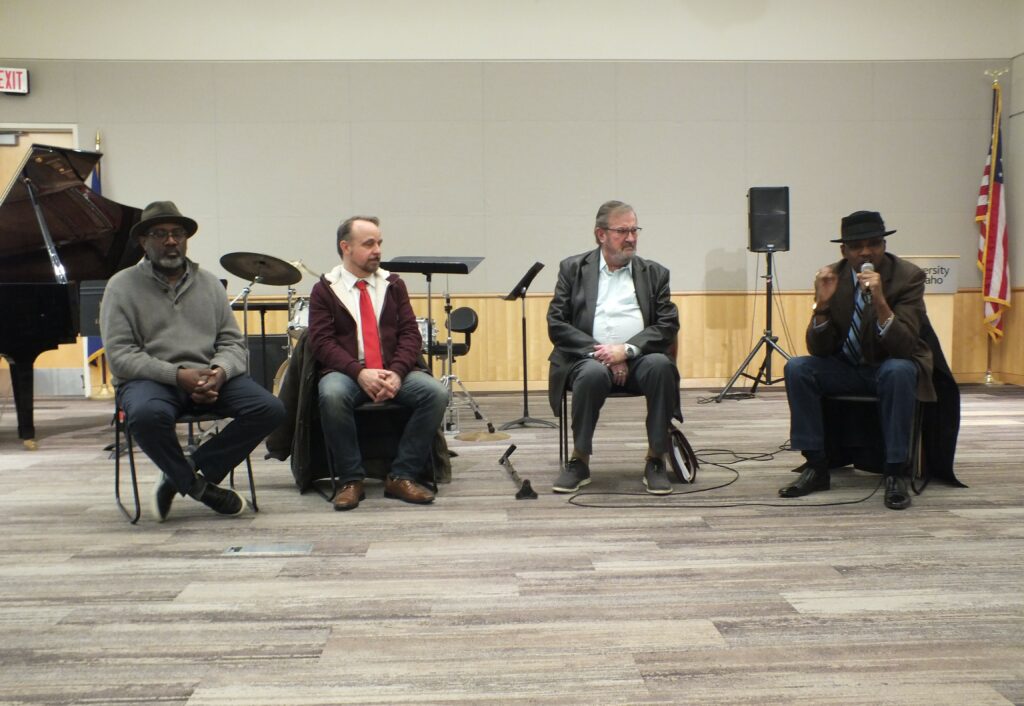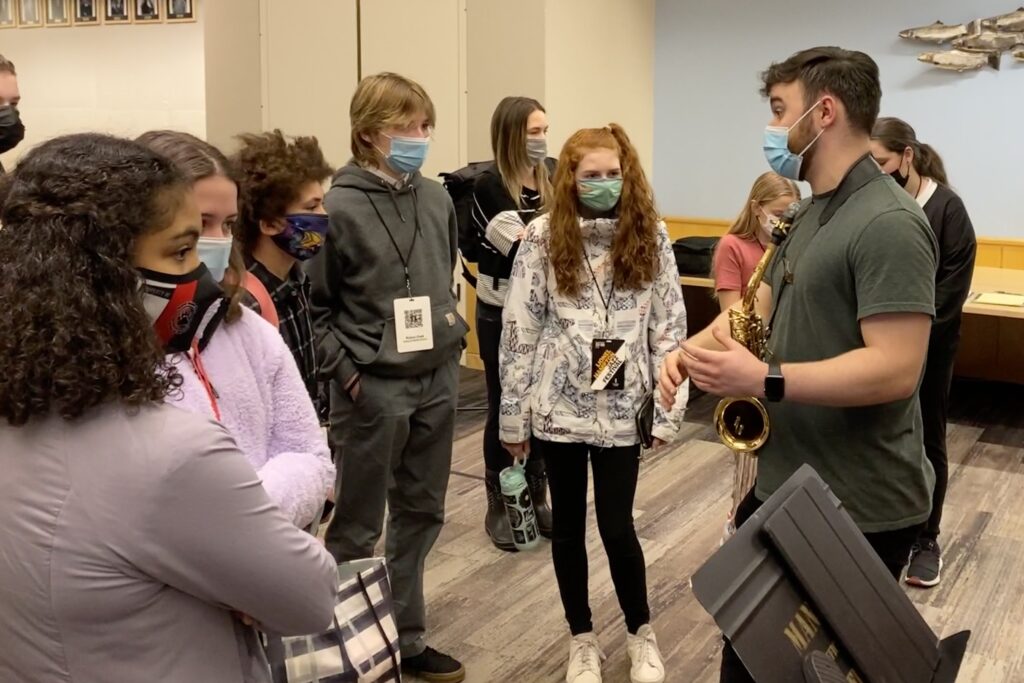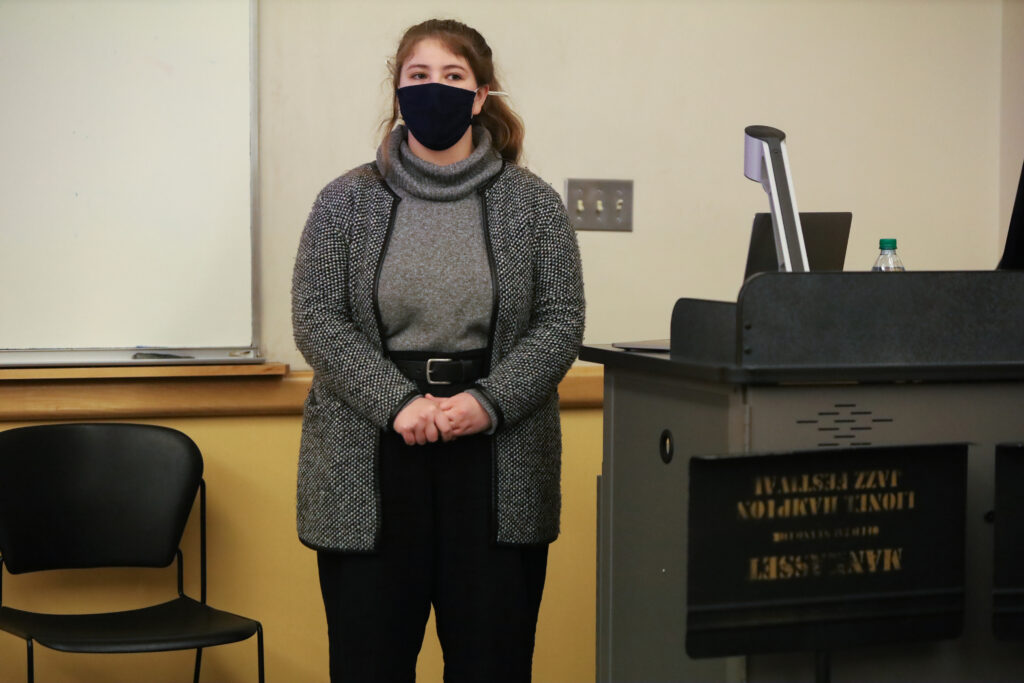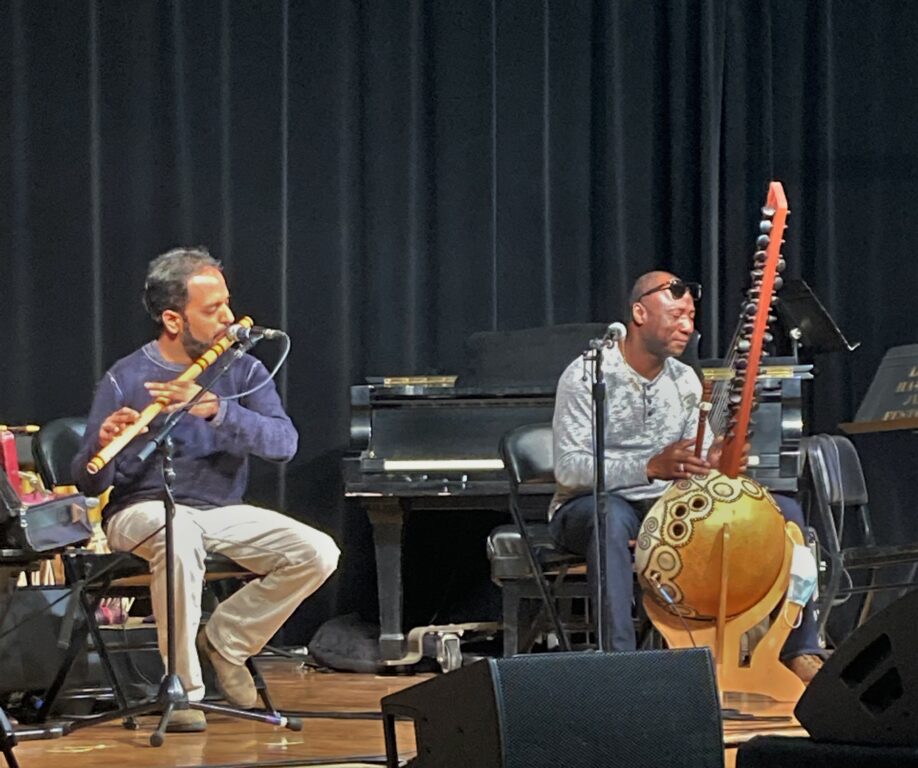Lionel Hampton: A Life of Achievement

Lynn Skinner and the Lionel Hampton Big Band reflected on the history of the annual jazzfest, sharing some sentimental memories.
Skinner, who is more fondly known as Doc, took over as executive director of the jazzfest in 1976. The Lionel Hampton Big Band co-leaders Cleave Guyton Jr., Lance Bryant and Christian Fabian spoke alongside Skinner.
Surrounded by the musicians of the big band that day, Skinner reflected, “I feel like I’m a little boy among giants.”
Skinner made great footing in growing the festival, working along with Lionel Hampton. In his time, Skinner brought in the likes of Sarah Vaughn, Ella Fitzgerald and, of course, Hampton.

At one year’s festival, Skinner sat down with Hampton at the catholic center, the one place they could get wine on campus. It was there that after talking with Skinner, Hampton took a check out of his pocket to put towards the festival.
One year Hampton and his band were about to go on stage and he demanded that Skinner introduce them.
“I gave him the intro worthy of a king,” Skinner described.
A lively audience, students jumped up from the crowd and followed the band onstage.
“I didn’t realize that when Hamp started playing, there would be a change in their hearts and in their lives,” Skinner said.
Eventually, the festival was renamed after Hampton due to his contributions and influence on the festival. This later contributed to the erection of the Lionel Hampton School of Music sign in 1987.
“We want to thank you,” Guyton said. “It took a lot.”
Guyton remembers that Skinner always stood up for the band.
“Every time we came out here, we knew we’d be treated like family,” Guyton said. “Everyone loves Doc.”
The festival had grown a sense of community among the musicians, and at the center of it was Skinner and Hampton.
“That makes it all better, to have the greatest people,” Skinner said. “It almost brings me to tears to be here with some of my best friends”
Thanks to the prominence of the festival, Hampton’s legacy continues on.
“I felt last night in that concert like he was sitting right next to me,” Skinner said. “He’d always reach over and very softly say he heard something beautiful. Because he knew, he knew it in his heart and his soul.”
Haadiya Tariq can be reached at [email protected] or on Twitter @haadiyatariq
The Musical Language

This year marks the second year of the Lionel Hampton School of Music’s Grammy Museum Affiliative Collective. The six-member ensemble, comprised of students from University Grammy Museum Affiliates, come from across and even outside the country for their performance.
Saxophonist Tony Brence is a fourth-year music major from UI’s own Lionel Hampton School of Music.
Trumpeter Banks Sapnar hails from Philadelphia and performs with the Temple University Jazz Band.
Drummer Joshua Cook is a fourth-year jazz studies major from Middle Tennessee State University.
Guitarist Scott Bentley of Oxfordshire, U.K. is in his fourth year of jazz performance studies at the University of Chichester Conservatoire.
Pianist Karen Shiraishi is a U.K. native based out of Louisiana and a graduate of the Berklee College of Music.
Bassist Weldon Scott is a Houston native and senior at California State University.
While one would think that an ensemble of such varied backgrounds would need an established history to put together a smooth performance, the group didn’t miss a beat in what was just their second time playing together.
Before Thursday, the group had only met together virtually to go over the details of the music, not being able to hear each other until the day of their first performance.
“We all flew in on Tuesday, met at 6 a.m. on Wednesday, which is a great first time to make impressions, and did some workshops for some kids,” Sapnar said. “First time we ever played together was in front of a group of high schoolers.”
In between songs, the group fielded questions from students regarding what helped give them the individual confidence to pursue an art form where improvisation is a defining element. The answer: sound bad practicing.
“When you’re in the practice room, you should sound pretty terrible if you’re doing it right,” Sapnar said. “If you don’t sound bad practicing, you’re doing it wrong.”
Brence added that the key to gaining confidence in his improvisation was focusing less on playing the right notes and more on playing in correct time.
“I know it sounds crazy, but I would rather be playing in time and play all the wrong notes than be playing all the right notes but out of time,” Brence said.
Royce McCandless can be reached at [email protected] or Twitter @roycemccandless
Ella Fitzgerald: Life, Career, and Fashion

The presentation featured the singer Ella Fitzgerald, focusing on her life, career and fashion.
The Berry International Jazz Collection fellow Destiny Angel-Hubble hosted the presentation. Angel-Hubble’s work for the IJC focused on digitizing the University of Idaho’s collection on Fitzgerald.
“I heard about it and I was like, ‘that is the coolest thing,’” Angel-Hubble said. “Then from there, I basically started looking at the collections when I started the project. I didn’t realize you could actually go into the reading room in the library and look at the collections.”
Angel-Hubble stated that her interest in Fitzgerald’s career came from the movie “Dream a Little Dream of Me” and wanting to pursue advocacy for women in jazz.
“I noticed there were only two collections on women, the Lee Morse collection and then Ella Fitzgerald,” Angel-Hubble said. “I thought that the Ella Fitzgerald collection could maybe bring more people in to love jazz because it’s a kind of a household name and everyone loves Ella.”
Angel-Hubble touched on the death of Janis Joplin and the appearances of female singers.
“During the time in the 70s, there were a lot of articles coming out about female musicians and these would highlight more their appearance and their sex appeal than it was their career,” Angel-Hubble said. “In this article, they outlined how attractive Janis Joplin was, in the bathroom that she died in during a heroin overdose.”
Daniel V. Ramirez can be reached at [email protected] or Twitter @DVR_Tweets
Meet the Artist

Meet the Artist was an introduction to Yacouba Sissoko and Jay Gandhi as a part of the World Music Celebration event. The two renowned musicians are from Mali and India.
They played a couple of classic West African songs and talked about their backgrounds and their instruments. Both Sissoko and Gandhi were surrounded by music from a very young age, starting to play their instruments as toddlers.
These musicians expressed a sense of connection to their instruments, saying they treat them like dear friends.
Gandhi played the bansuri, a kind of flute made from bamboo. Sissoko played the kora, a West African harp.
This harp has a lot of cultural significance to Sissoko. He sees his harp as a royal instrument that is very important to him.
The audience was enthralled with the musicians and what they had to share.
“That was so inspirational, seeing them play with so much passion and having that connection with both their instruments and each other as they played,” UI music student Rachael Crabb said. “They really love what they do”
The workshop also served as an educational experience for its audience. “I learned so much about improvisation, taking passion, and expressing myself through my music,” Crabb said.
Jess Englis can be reached at [email protected]
The Swing Kids in Nazi Germany
Jazz’s rich history extends not only to the United States, where the genre originated, but to Germany during the reign of Adolf Hitler and the Nazi party. The music was censored throughout Nazi Germany, but large groups of German youth banded together to rebel against their government and enjoy the blues and ragtime.
Rachel Halverson, department chair for modern languages and culture, and professor of German at UI, delivered a workshop detailing the Swing Kids of Nazi Germany. Halverson kicked off her presentation asking the attendants what came to mind what they associated with jazz and what they thought of about Nazi Germany.
Several students said they associate jazz with freedom and expression, contrasting with the suppression and restriction affiliated with Nazism. Halverson said the same year the Hitler Youth organization was formed, the Swing Kids banded together to clash with expectations of the Youth.
Opposite of the uniformity pushed on the young people in Germany, the Swing Kids dressed freely, wearing their hair loose, dressing in colorful clothing and secretly dancing to jazz music.
Halverson showed documentary footage of Ken Burns’ “Jazz” documentary, which features Duke Ellington’s trip to Germany, prior to Hitler’s initial takeover.
Halverson said she wanted to explore the link between jazz and her main field of study, German. She’s also said she’s interested in examining the freedoms we enjoy and how willing people are to sacrifice those freedoms.
“I’m fascinated between music and culture,” Halverson said.
Sierra Pesnell can be reached at [email protected]
